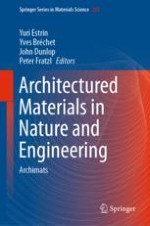2019 | OriginalPaper | Chapter
9. Architectured Polymeric Materials Produced by Additive Manufacturing
Authors : Andrey Molotnikov, George P. Simon, Yuri Estrin
Published in: Architectured Materials in Nature and Engineering
Publisher: Springer International Publishing
Activate our intelligent search to find suitable subject content or patents.
Select sections of text to find matching patents with Artificial Intelligence. powered by
Select sections of text to find additional relevant content using AI-assisted search. powered by
